Despite recent technical developments in scientific laboratories, the Neubauer chamber remains the most commonly used method for cell counting worldwide. This fact sheet has been prepared to assist both experienced and inexperienced researchers in performing a proper cell count using a Neubauer chamber or hemocytometer. The principles described in this fact sheet apply to any cell counting chamber, although the dimensions and volumes of each chamber may differ. The fact sheet describes best practices, applications, and recommendations for performing a cell count.
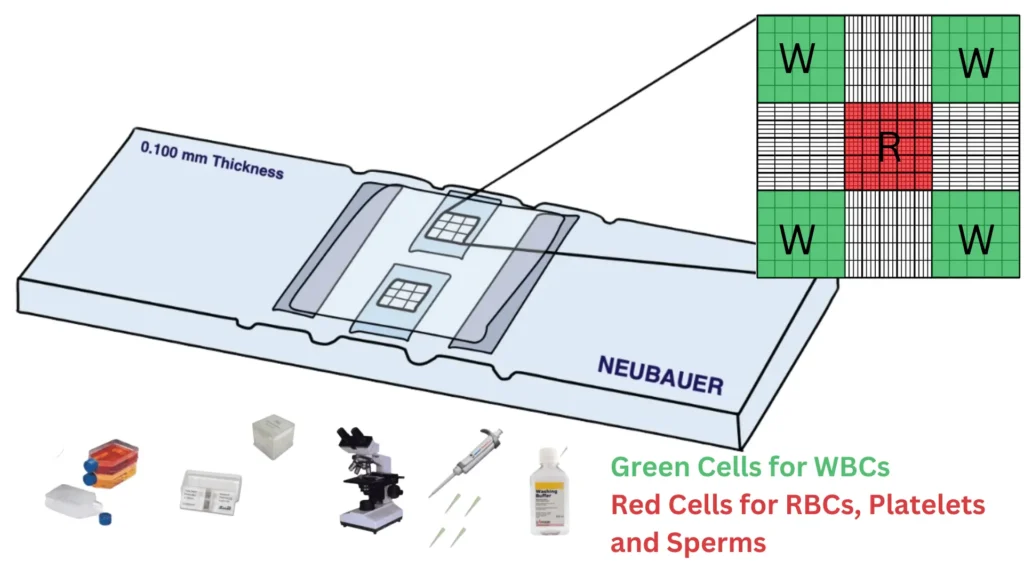
Also Known as: Neubauer Haemacytometer, Neubauer Counting Chamber and Haemocytometer
Haemo : Blood
Cyto: Cell
Meter: It’s Meter (Instrument Name)
The Neubauer Chamber is used to count cells in a biological fluid by viewing a calibrated grid under a microscope whose exact dimensions (including depth and volume) are known. A simple calculation allows you to determine the number of cells per ml or other unit of volume.
Neubauer Chamber Specifications:
- Improved model: 5 x 5 (bright line)
- Depth: 0.1 mm
- Surface 0.0025mm2
- Volume: 0.9 mm3
- Double engraved grid
- Supplied with 2 glass planed cover slides (20 x 26 mm)
Types of Neubauer Counting Chamber:
Here are Common 7 different types of Neubauer counting chambers that vary in their design and applications:
- Old Neubauer chamber: Improved grid lines for accurate cell/particle counting.
- Malassez chamber: Deeper chamber and thicker grids for larger cells/particles.
- Nageotte chamber: Two chambers for simultaneous sample counting.
- Bürker chamber: Smaller grid, ideal for small cells like RBCs.
- Fuchs-Rosenthal chamber: Circular chamber for larger area counting.
- Hemacytometer: General term for counting chambers, often refers to Neubauer chamber.
| Type of Neubauer Counting Chamber | Grid | Size | Area of 1 square | Volume of 1 square | Multiplication Factors |
|---|---|---|---|---|---|
| OLD Neubauer counting chamber | 3×3 mm | 0.1 mm deep | 1/9 mm² (0.1111 mm²) | 0.0001 mm³ (0.1 nl) | 10 (for diluted samples) |
| Improved Neubauer counting chamber | 3×3 mm | 0.1 mm deep | 1/9 mm² (0.1111 mm²) | 0.0001 mm³ (0.1 nl) | 10 (for diluted samples) |
| Malassez counting chamber | 1×1 mm | 0.2 mm deep | 1/100 mm² (0.01 mm²) | 0.0002 mm³ (0.2 nl) | 1 (for undiluted samples) |
| Nageotte counting chamber | Two separate chambers, each with 3×3 mm grid | 0.2 mm deep | 1/9 mm² (0.1111 mm²) | 0.0002 mm³ (0.2 nl) | 10 (for diluted samples) |
| Bürker counting chamber | 3×3 mm | 0.1 mm deep | 1/9 mm² (0.1111 mm²) | 0.0001 mm³ (0.1 nl) | 10 (for diluted samples) |
| Fuchs-Rosenthal counting chamber | Circular chamber with 20 mm diameter | 0.1 mm deep | 1.9635 mm² | 0.0002 mm³ (0.2 nl) | 10 (for diluted samples) |
Neubauer Chamber Design and Parts:
- Base plate: Rectangular slide with a recessed grid area.
- Counting grid: Parallel lines divide the central area into squares.
- Cover slip: Thin glass/plastic piece creating a chamber of fixed depth.
- Loading port: Channel for sample loading.
- Side borders: Raised edges hold the cover slip and protect the grid.
- Central barrier: Separates the grid, prevents mixing, and reduces evaporation.
- Chamber depth: Fixed at 0.1 mm for accurate volume measurement.
Neubauer Chamber Grid Sizes:
- Central square: Divided into 25 smaller squares, each further subdivided into 16 even smaller squares. These grids is used for RBC and Platelets Counting.
- 4 Corner squares: Each divided into 16 smaller squares. These grids is used for WBC Counting.
Corner Rquares – For WBC

- Each of the 16 smaller squares is 0.25 mm on each side, with an area of 0.0625 mm² (1 mm² / 16).
- These squares are suitable for counting cells 10 μm or larger, such as white blood cells (leukocytes).
- Including counts from the central square is optional but can be beneficial.
Central Square – For RBCs, Platelets, Yeast and Sperm Cells:
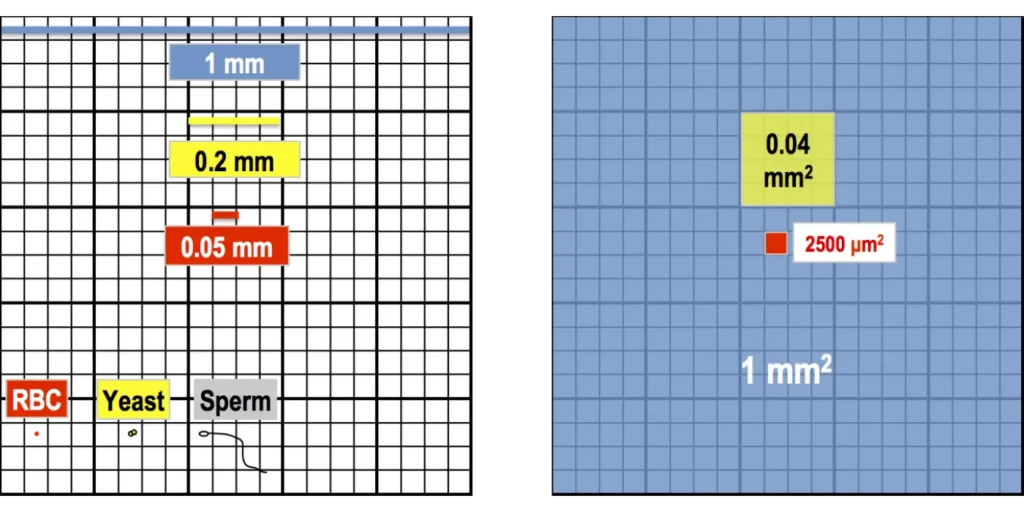
- Each of the 25 smaller squares:
- Dimensions: 0.2 mm x 0.2 mm
- Area: 0.04 mm² (1 mm² / 25)
- Each smaller square contains 16 even smaller squares:
- Dimensions: 0.05 mm x 0.05 mm
- Area: 0.0025 mm² (2500 μm² or 0.04 mm² / 16)
- Suitable for counting: Cells 10 μm or smaller, such as red blood cells, platelets, yeast, and sperm cells.
Strategies for Counting Cells:
Before you start counting, you need to decide which squares of the hemocytometer counting grid you will count. It is critical to choose squares that give a good overall representation of the cells on the slide. For example, avoid counting only the cells in the top three squares of the grid, as this may not be representative if the liquid was not spread evenly across the entire surface of the slide when dispensed from the pipette. Some common strategies reported by our in-house scientists include:
The Logical Count:
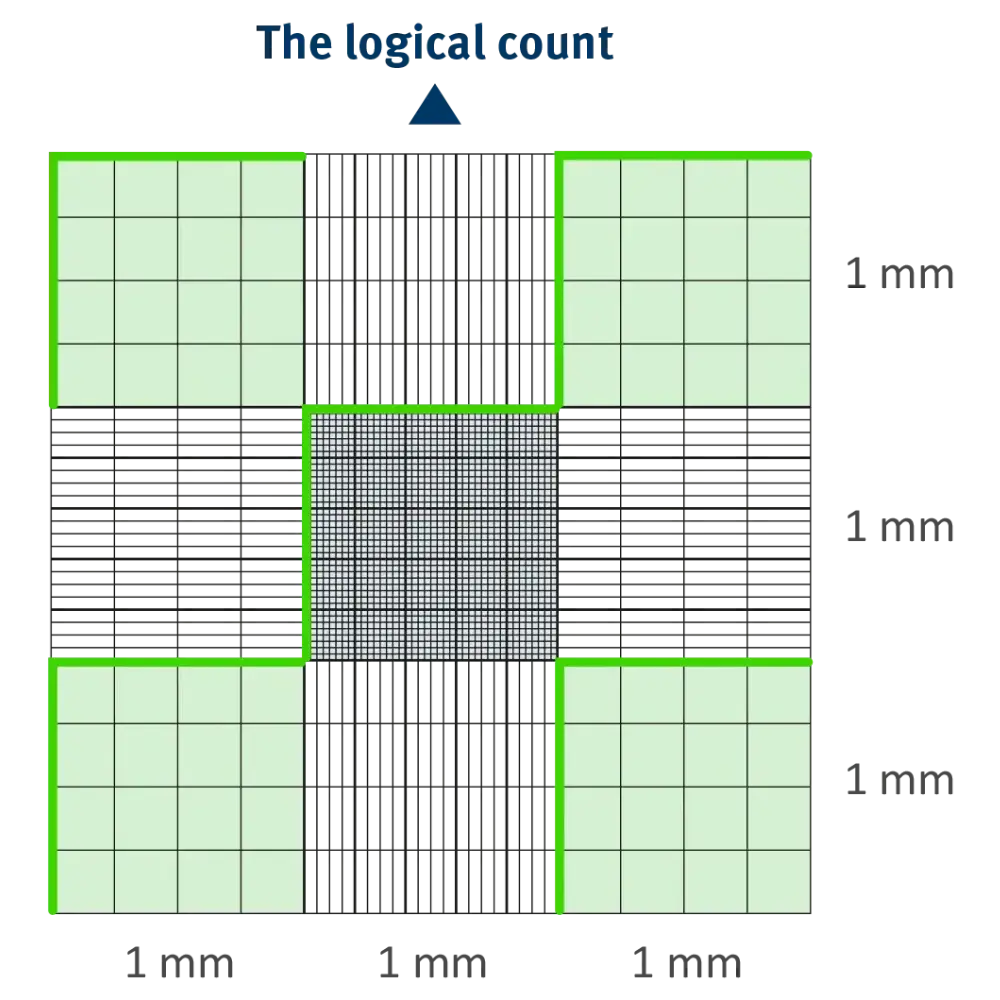
A common and representative approach is to count the cells in the four corner squares and the middle square of the hemocytometer grid. This is called “logical counting.”
The Absolute Count:
Alternatively, you can count the cells in all nine squares of the hemocytometer. In this method, known as “absolute counting,” you count the cells in all squares while following a zigzag pattern. This counting method is advantageous when there is a high concentration of cells in the sample because it is an easy pattern to follow, so you are less likely to get lost and have to restart.
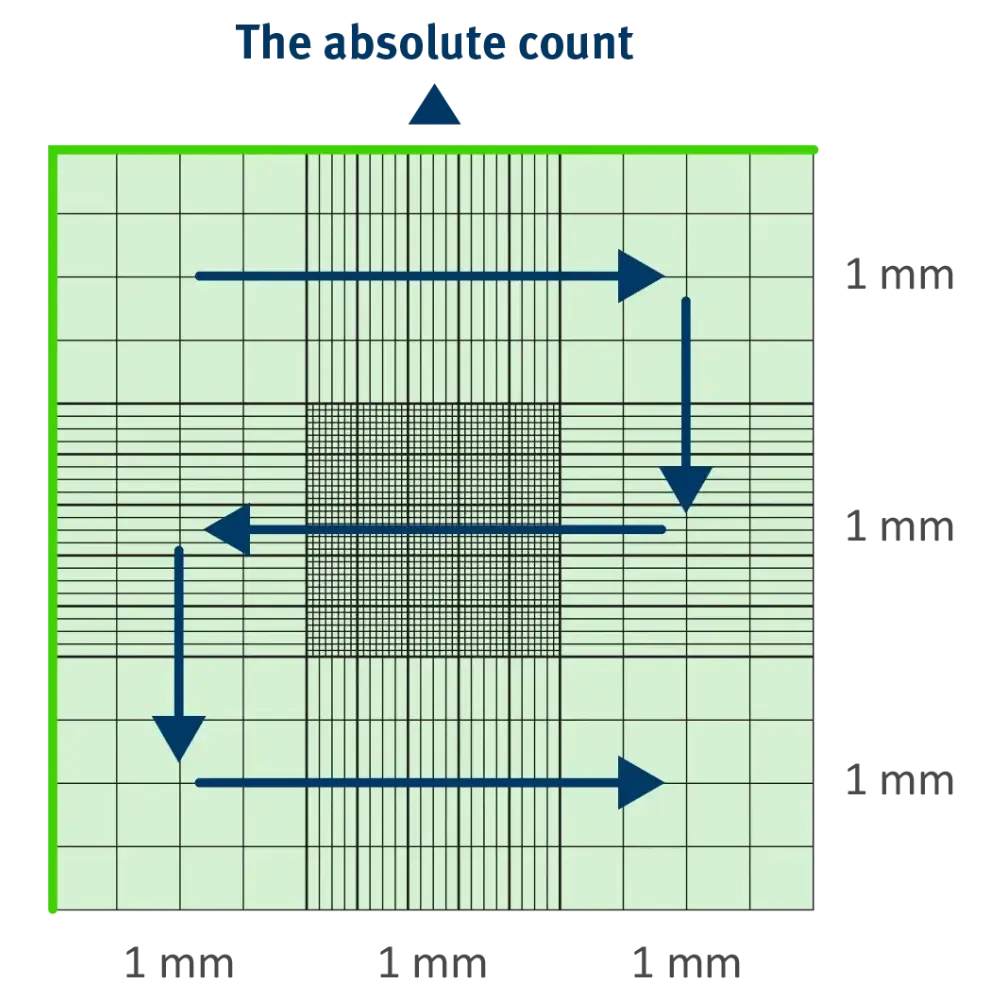
The Quick Count:
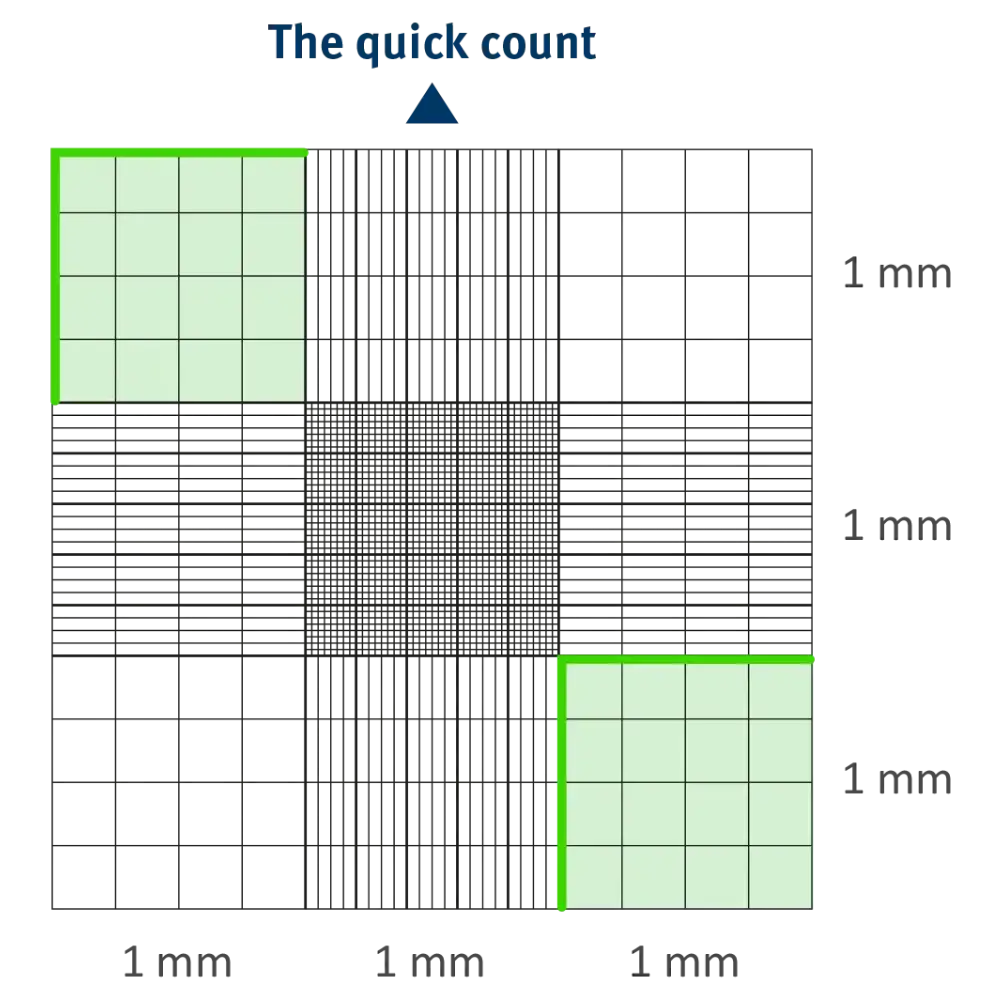
Finally, if you are in a hurry, you may be tempted to do the “quick count.” With this method, you only count the cells in two squares that are diagonally opposite each other. If you use this approach, your results will not be as representative, but it can be a good way to randomly check your cell culture if you are in a hurry.
Rules for Neubauer Chamber Uses:
- Calibrate the chamber: Ensure accuracy before use.
- Prepare and dilute the sample: Achieve appropriate cell concentration.
- Mix the sample: Ensure even cell distribution.
- Load the chamber: Avoid air bubbles.
- Allow sample to settle: Let cells distribute evenly for a few minutes.
- Place under microscope: Adjust focus and lighting for a clear view.
- Count cells: Use 10x or 20x magnification, counting cells touching the top and left sides of each square. Avoid cells on the bottom or right sides.
- Count systematically: Move across the grid, counting each square.
- Repeat counts: Perform at least two more counts for accuracy and calculate the average.
- Record results: Calculate final cell concentration, considering the dilution factor.
- Clean and store: Thoroughly clean the chamber and store it safely.
Cells Counting Procedure on Chamber:
- Clean chamber: Wipe with 70% ethanol and a lint-free cloth.
- Prepare sample: Mix well, dilute if needed.
- Load chamber: Pipette sample into loading area, filling both sides.
- Let cells settle: Wait 10-15 minutes in a humidified chamber.
- Count cells: Use a microscope (10x objective) and apply counting rules.
- Repeat if needed: Count more samples for accuracy.
- Clean & store: Clean with ethanol and store safely.
Requirements for Counting:
- Neubauer chamber/hemocytometer
- Microscope (10x objective, 10x ocular)
- Pipette for sample loading
- 70% ethanol for cleaning
- Lint-free cloth/tissue for cleaning
- Cell sample for counting
- Humidified chamber for settling cells
- Timer for tracking settling time
- Gloves and lab coat for protection
- Calculator for cell count calculations
- Distilled water for sample dilution
Procedure for Filling the Sample:
- Aspirate 10 µL of dilution with a micropipette.
- Place cover glass on the Neubauer chamber.
- Attach tip to the micropipette.
- Set pipette to 10 µL.
- Aspirate sample slowly.
- Transfer sample near the cover glass.
- Release plunger slowly to fill the chamber.
- Check for bubbles and repeat if needed.
Cell Counting Process:
- Position the Neubauer chamber: Place the chamber on the microscope stage, using a fixation clamp if available.
- Turn on the microscope light: Ensure proper illumination for clear visibility.
- Focus the microscope: Look through the eyepiece and adjust the stage until you get a sharp image of the cells.
- Locate the first counting square: Identify the first square of the grid where cell counting will begin (typically, 5 large squares are counted in the improved Neubauer chamber).
- Start counting cells: Count the cells in the first square, applying the counting rule.
- Note: Count cells touching the upper and left boundaries, but not those touching the lower and right boundaries.
- Record cell count: Write down the number of cells counted in the first square.
- Repeat for other squares: Continue counting and recording the number of cells in the remaining squares for greater accuracy. The more cells counted, the more reliable the measurement will be.
Calculations:
We apply the formula to calculate the concentration:
Concentration (cell/ml) = Number of cells/Volume (in ml)
The number of cells will be the sum of all counted cells in all counted squares.
Since the volume of 1 large square is:
0.1 cm x 0.1 cm = 0.01 cm2 of area counted.
Given that the depth of the chamber is 0.1 mm:
0.1mm=0.01cm
0.01cm2 x 0.01cm = 0.0001cm2 = 0.0001ml = 0.1µl
So for the Neubauer chamber, the formula used when counting in the large squares is:
Concentration = Number of cells x 10,000 / Number of squares
In the event that a dilution has been applied, the obtained concentration must be converted to the original concentration before dilution.
In this case, the concentration must be divided by the applied dilution. The formula will be:
Concentration = Number of cells x 10,000 / Number of squares x dilution
- For a 1:10 dilution → Dilution = 0.1
- For a 1:100 dilution → Dilution = 0.01
References:
- Neubauer Chamber (Neubauer Hemocytometer) |Electron Microscopy Sciences | https://www.emsdiasum.com/docs/technical/datasheet/68052-14 – (Accesscd Sep 12, 2024)
- Hemocytometer | Wikipedia | https://en.wikipedia.org/wiki/Hemocytometer – (Accesscd Sep 12, 2024)
- How to count cells with a hemocytometer – ChemoMetec| https://chemometec.com/how-to-count-cells-with-a-hemocytometer – (Accesscd Sep 12, 2024)
- Hemocytometer | https://www.hemocytometer.org | – (Accesscd Sep 12, 2024)
- Vembadi A, Menachery A, Qasaimeh MA.: Cell Cytometry: Review and Perspective on Biotechnological Advances. Front Bioeng Biotechnol. 2019;7:147.
- Electron Microscopy Sciences: Neubauer Haemocytometry.
- Stoddart MJ.: Cell viability assays: Introduction. Methods Mol Biol. 2011;740:1-6
Possible References Used







One Comment